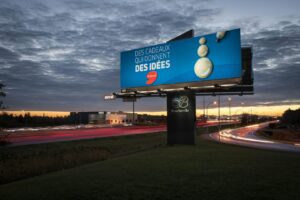Back in 2017, out-of-home (OOH) advertising was at a crossroads, facing challenges like the loss of traffic cameras and counts it relied on to sell billboard advertising as municipalities cut budgets.
That’s when COMMB, the not-for-profit Canadian Out-of-Home Marketing and Measurement Bureau, came together to fund a new approach to modelling impressions for OOH ads, in a digital environment where buyers and agencies have become accustomed to the type of analytics supplied by advertising platforms like Google and Facebook.
Like radio, OOH has been grappling with changing consumer behaviours as more people work from home.
“Maybe people aren’t working five days a week from the office anymore, but they are out there and might just be in different times of day and for different reasons,” said Michele Erskine, COMMB Chair and VP of Out-of-Home for Astral. “But they’re out there.”
With traffic volumes down as much as 75% at their low ebb during the pandemic, Erskine said they were able to rebound to 2019 revenue numbers as quickly as 2022, thanks in part to the steadfastness of advertisers from the fast food industry. However, the pandemic delayed COMMB’s plans to update their dataset. Their launch is now set for early 2026.
What can radio learn?
Erskine, who formerly worked in research at both Media Buying Services (MBS) and Corus Radio, said that like OOH, the radio sector needs to come together to move forward. She said that starts with a sense of collegiality.
 “I feel that we still have it at out-of-home…that doesn’t mean they don’t sometimes have, you know, differences of opinion, but…we’ll try and think about what’s best for the industry ahead of each of us,” said Erskine. “It’s one of the things that’s kept me in out-of-home is that sense of we need to work together to grow the business and duke it out over the individual buys.”
“I feel that we still have it at out-of-home…that doesn’t mean they don’t sometimes have, you know, differences of opinion, but…we’ll try and think about what’s best for the industry ahead of each of us,” said Erskine. “It’s one of the things that’s kept me in out-of-home is that sense of we need to work together to grow the business and duke it out over the individual buys.”
How do you get competitors to work together towards a common goal? Erskine said it was a shared foresight to fund improved measurement, however the challenge of acceptance of an agreed modeling structure was the next hurdle.
“We’ve had Michele on thousands of calls with our members on just that, just talking about the data and how the data comes to exactly where it is, what goes into the data, what comes out of the data,” added Rodney Binsnath, Director, Research & Measurement at COMMB. “I think it’s always hard when you’ve got some members who, you know, really want to go very high tech and then some who are like ‘well, what we have is enough.'”
Erskine said at the end of the day, COMMB’s members have agreed to “just take steps together” and do the best they can.
“I think every time we’ve managed to move forward, it’s been because we were able to get the leadership at each of the largest membership companies to come together and agree that we were gonna stand together to do something.”
Comparisons to radio
With COMMB facing challenges similar to radio between unrated markets and the loss of measurement in diary markets, the organization’s initiative on the metrics issue has inspired Pattison Media to move forward with its own radio metrics measurement system, Validate.
At a 2019 conference, Pattison Media Director of Digital Andrew Snook spent some time with his counterparts from Pattison Outdoor, who shared how they were modelling impressions for billboard ads and presenting metrics to advertisers in a digital-dashboard style. With more and more Pattison advertisers becoming accustomed to that type of reporting in their digital ad campaigns, Snook saw a dashboard as a great solution to show the effectiveness of radio, in the form that advertisers wanted.
“Advertisers want to know the number of impressions that their ads receive, and how many people are responding to those ads,” said Snook. “Obviously we can’t track impressions or conversions on broadcast listening, but we can do that for ads that are heard on the stream, and then extrapolate to get an estimate of what’s happening on broadcast. That involves modelling. There’s no way to know exactly how many ads are heard on an FM signal. But seeing how advertisers have accepted impression modelling for OOH advertising, this gives us a pathway to do the same in radio.”
“It’s really inspiring to see how the OOH industry has come together, and worked collaboratively to modernize their measurement system to speak to the needs of the advertisers,” he added.
Snook says impression modelling opened up the opportunity for Pattison Outdoor and others in the space to sell their inventory programmatically, making it easier for advertisers to buy – and spend more.
“That’s happened in the OOH space, and we can follow their lead,” said Snook. “Radio remains difficult to buy, and even harder to quantify its effectiveness. I’m convinced that this is a big part of why national revenue remains challenging. We developed Validate to address these challenges at the local level, and feel that there is an opportunity for our whole industry if we can align on a standard solution at the national level – whether that’s Validate or something else, but we desperately need a solution.”
[Full disclosure: Broadcast Dialogue’s parent company, Momentum Media, creates, develops, and markets brands, content, software and tools that advance the broadcast industry, including Validate.]




